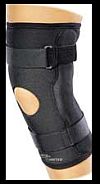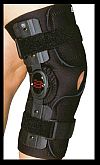|
|
Knee brace for skiers.
What type of a knee brace do I need?
Like most sub-specialties the choice you will make in knee brace selection is driven by the type of injury you have sustained. I have touched up on the more common type of knee injuries and braces required, interested?....read on.
- Ligament sprains
Our knee joints are held together by tough bands of connective tissue called ligaments. Sudden twists or excessive forces exerted on the knee joints, or just simply repeated overuse in the arena of jumping, riding over moguls, or coming to a rapid halt while skiing, can stretch ligaments beyond their limits. As the ligaments are torn and tissue damage is sustained inflammation follows. Soon swelling and pain become your new friends. The anterior cruciate ligament (ACL) situated in the centre of the joint ends up being the knee ligament which is commonly injured. Your brace needs to have all the features of a specialized brace, with some patella support, as well as some sideways stability control, or arms support.
- Tendon tears
The muscles are anchored to the joints with tendons. Overstretched tendons can tear and bleed, but these injuries tend to heal by themselves without the need for surgery. Among skier they are a less common type of knee injury. A general compress ional type of a knee brace may be sufficient to support your knee.

- Cartilage tears
Our knee joint is held together on both sides by strips of cartilage, called ‘menisci’ or semi lunar cartilages. One of the most common knee injuries is a torn or split meniscus. with skiers possibly medial meniscus. Severe impact or twisting, especially during weight bearing exercise, can tear this cartilage. Symptoms include swelling, pain and the inability to straighten the leg. To assist with this disability, a knee brace which stabilizes the sideways swaying of the knee is required for support .These braces have side mounted arms, which mimic the movement of flexion and extension of the leg. You will look like a robot on ski slopes at least ensure that the brace fits under your ski pants before you buy one.
Aggie in her gentle suave-type of skiing has sustained an injury of the meniscus, which initially responded well to a normal compression brace, later however arm bracing was necessary. Not before too long of course, her orthopedic friends rubbed their hands together commenting another skier to add to our list,in anticipation awaiting to perform arthroscopy.Few jokes aside the job was well done!

- Patello (knee cap)-femoral(hip-knee bone) pain syndrome
Patello-femoral pain syndrome is characterized by pain felt behind the kneecap. Squatting, walking up and down hills or stairs, or sitting still for extended periods of time can exacerbate the pain. This pain usual is derived from abnormal movement of the kneecap as the knee is bent and straightened. This can lead to wear and tear of the cartilage on the back of the kneecap.
Your knee brace needs to stabilize the patella, hence will have a circular padding at the front and padding to the side of the knee. Depending on the nature of degeneration of the patella and the surrounding structures side arm bracing may be required. It is rare to find skiers with advanced degeneration of the patella who still ski. Then again never say never?
From knee brace for skiers back to ski equipment page.
|
|






